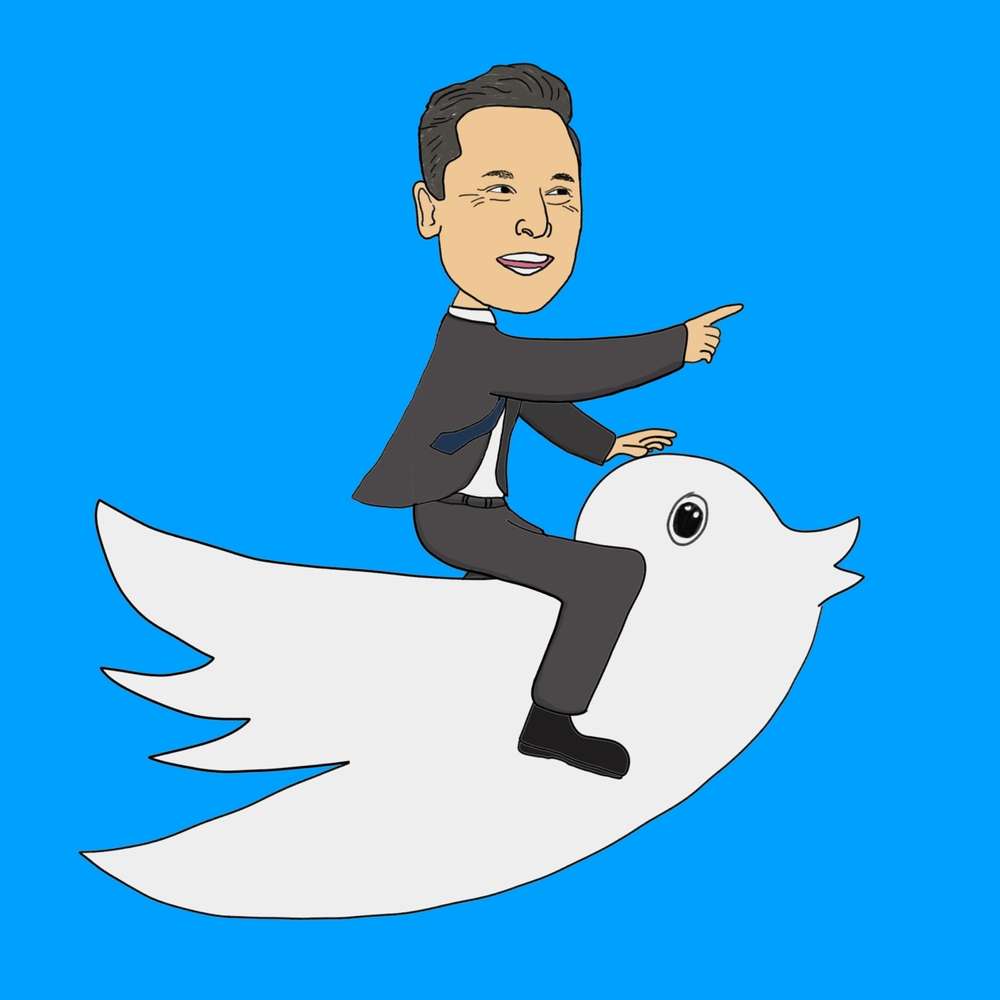
Still on Twitter/X?
If you are – and yes, I am – you might be wondering about the net effect of Elon Musk’s takeover exactly one year ago. You probably remember the chaos – Musk walking into company headquarters on Day One carrying the kitchen sink, mass layoffs, demands to bring the remaining staff to the work place, content breaches, the blue checkmark kerfuffle, a new CEO and estimates of massive losses. And through the initial months of Musk’s management, the landscape was filled by finger-pointing and innuendo.
The innovative founder of SpaceX and Tesla took to Twitter to bombastically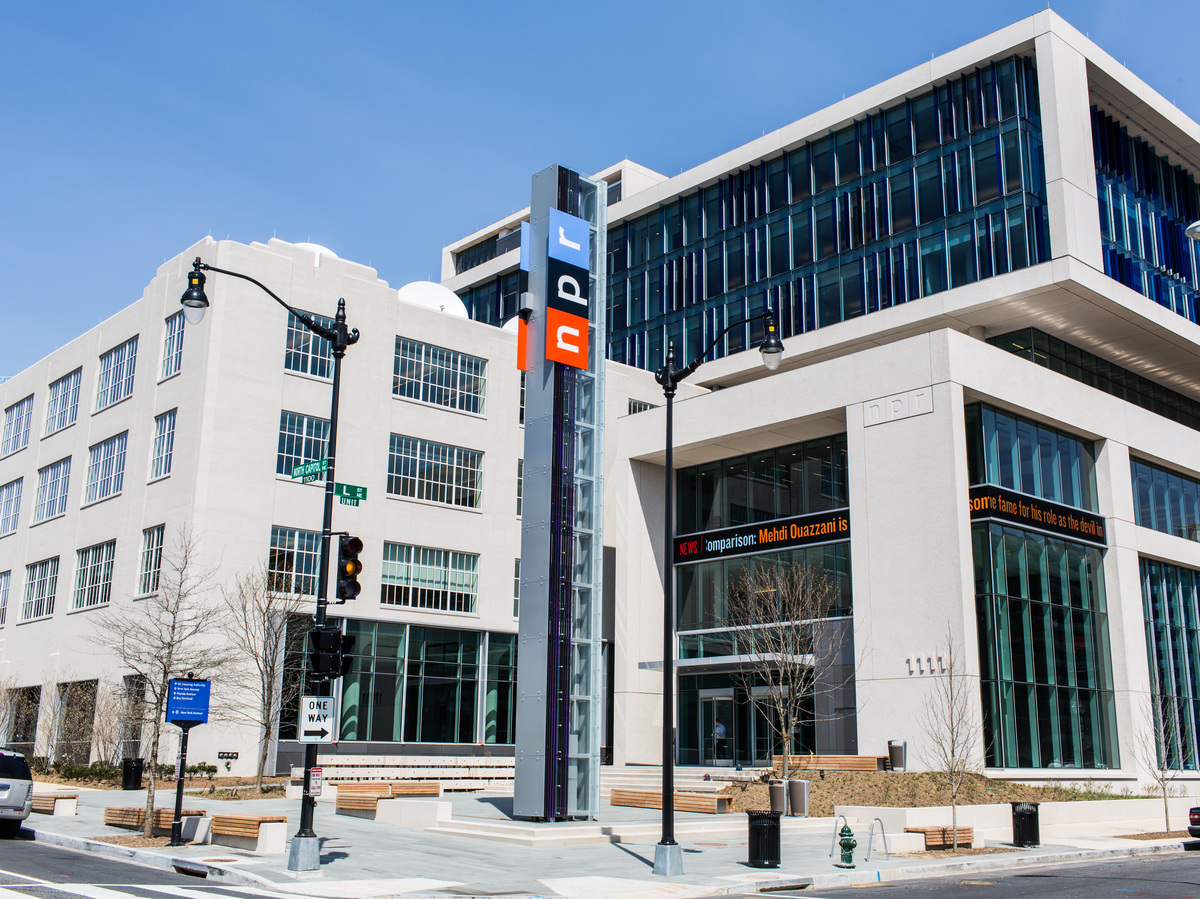 challenge the platform’s policies and conventions. During the early months of 2023, no controversy was more intense than the blowup between the company formerly known as Twitter and NPR, the network that creates and produces many of the successful news programming you hear every day on public radio here in the States.
challenge the platform’s policies and conventions. During the early months of 2023, no controversy was more intense than the blowup between the company formerly known as Twitter and NPR, the network that creates and produces many of the successful news programming you hear every day on public radio here in the States.
In case you forgot, Musk sent the initial shot across the bow, reclassifying NPR as “U.S. state-affiliated media” – the same designation it uses for propaganda channels in countries like China and Russia.
After some back and forth jousting between Musk and NPR CEO John Lansing, Musk walked it partially back, changing NPR’s status to “government funded media.” NPR called the move inaccurate and misleading. And in response, they stopped posting on Twitter, and one week later in April, NPR pressed “submit” on their last message.
— NPR (@NPR) April 12, 2023
NPR has not tweeted on Twitter since. Their account, however, remains active.
As Bullard reports, other public radio stations followed suit: KUOW (Seattle), LAist in Los Angeles, KCUR (Kansas City), and Minnesota Public Radio among them.
These circumstances set up an interesting social media experiment. What would happen to overall traffic if an active news organization – in this case, NPR – stopped tweeting/posting for months on end on Twitter?
Some speculated NPR would quickly feel the effects of traffic losses as a result of their Twitter exodus. The concern was that of all the social media platforms, Twitter has often been considered the go-to portal in the political, journalistic, and cultural spaces.
In a new analysis, Nieman Lab‘s Gabe Bullard reports the effect of NPR’s absence on Twitter after six months:
“Negligible.”
An NPR staff memo maintained that overall traffic was off just one percentage point during the last half year. And the network noted Twitter’s algorithm “made it increasingly challenging to reach active users; you often saw a near-immediate drop-off in engagement after tweeting and users rarely left the platform.”
The conclusion: Twitter/X may not be worth the effort.
But what about the audience? As a result of the war of the words between Musk and Lansing, followed by Twitter’s departure, what do listeners think?
We included questions in the Public Radio Techsurvey – fielded in July and August – designed to learn just that. The summary below shows listeners are generally unhappy with Musk’s version of Twitter/X:
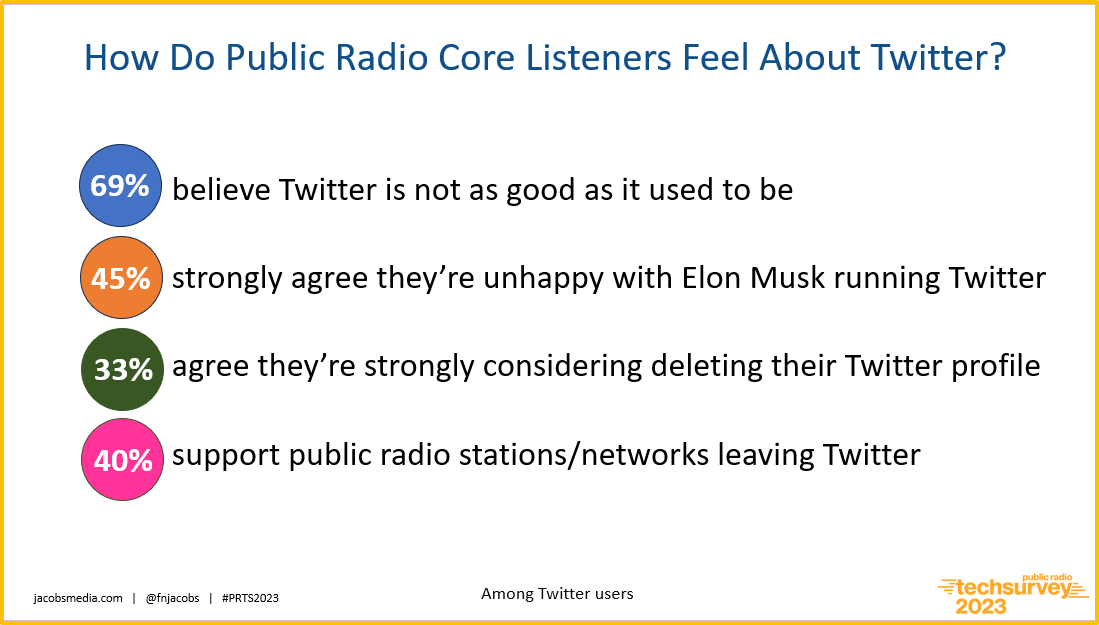
Whether it’s NPR or public radio stations, most are not missing Twitter, nor are they enamored with Musk’s management.
In the Nieman Lab story, Bullard asks whether it is just Twitter alienation or a larger malaise toward social media in general. The public radio audience skews older, possibly explaining why only around seven in ten (72%) have a social media profile anywhere. In our Christian music and commercial radio Techsurveys, social media penetration is considerably stronger.
A look at public radio’s social media “cume” (the sites where listeners have an account) and “TSS” (time spent socializing”) – do they visit these social media platforms at least daily? – reveals relatively low levels of engagement in the social space.
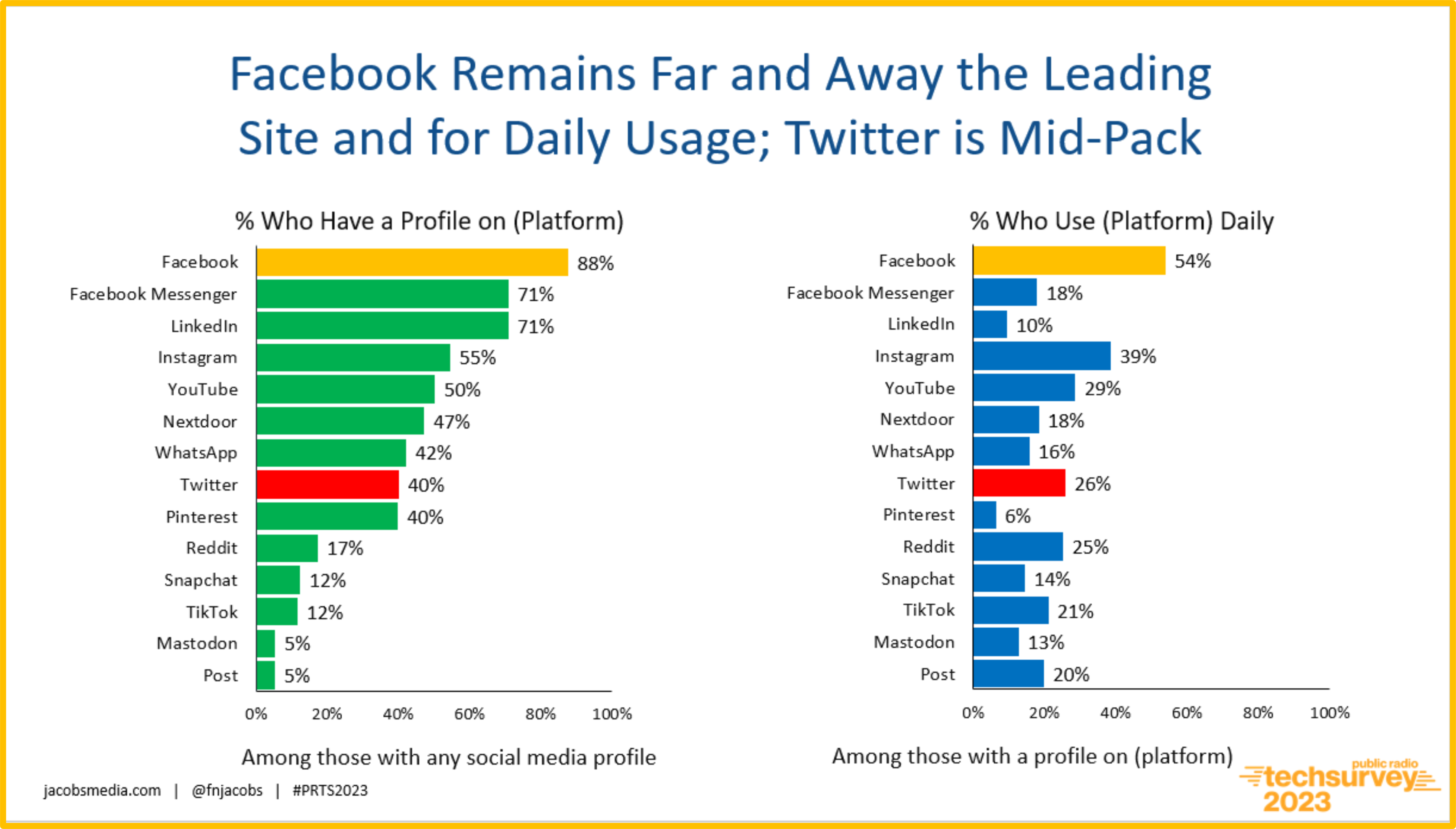
Aside from Facebook where public radio listeners are most likely to hang out with regularity, none of the other social media platforms captures a great deal of time or attention. (The results, of course, differ greatly by public radio format and individual station brands.) The red bars show Twitter mid-pack: Four in ten (40%) social media users have a Twitter profile (down from 48% in PRTS 2022); of them, about one in four (26%) uses Twitter or more often.
(HOW TO READ: Of those with a social media profile, 88% are on Facebook. Of them, 54% use Facebook at least daily.)
Outside of Facebook, then, what is the ROI in time, effort, and personnel in being highly active socially? This is a question more and more public media organizations may grapple with, particularly given widespread employee cutbacks this year.
How is staff creative time and energy being spent? On Instagram? Writing a newsletter? Producing a podcast? Planning a station event?
The results of the City Square “Meta-Analysis” and the subsequent “Playbook”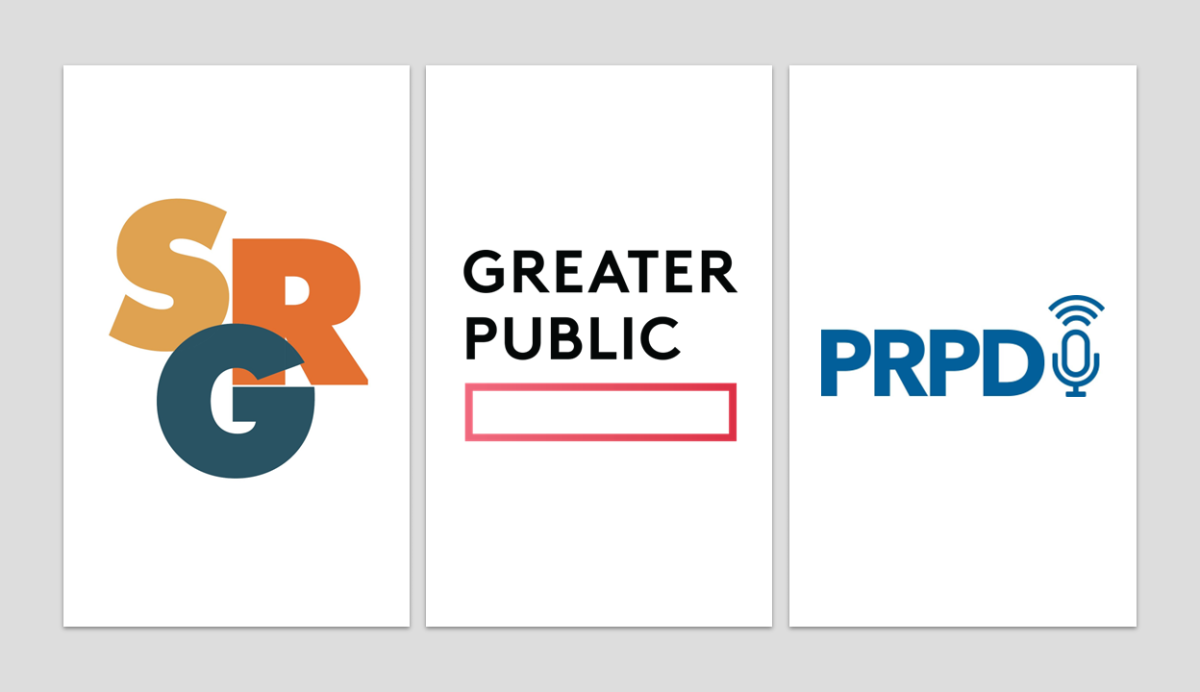 (commissioned by SRG, PRPD, and Greater Public) strongly suggest public media brands invest in local research in order to answer questions about how to best foster a more meaningful sense of connection with the audience. (You can access both reports on the PRPD website.)
(commissioned by SRG, PRPD, and Greater Public) strongly suggest public media brands invest in local research in order to answer questions about how to best foster a more meaningful sense of connection with the audience. (You can access both reports on the PRPD website.)
The Twitter/NPR imbroglio suggests the answers may be more complicated than anyone originally thought. It appears that NPR – and like-minded public radio stations – have barely missed a beat these past six months of their self-imposed Twitter exile.
I am thinking social media experts, such as Lori Lewis, might view these results differently. And I welcome their feedback here.
 Since NPR stopped tweeting, the platform is now called X (although tweets are still called tweets). And perhaps we’ll soon start reading about its value after one year under Musk’s management.
Since NPR stopped tweeting, the platform is now called X (although tweets are still called tweets). And perhaps we’ll soon start reading about its value after one year under Musk’s management.
It is already one of the strangest chapters of the tech revolution.
- What To Do If Your Radio Station Goes Through A Midlife Crisis - April 25, 2025
- A 2020 Lesson?It Could All Be Gone In A Flash - April 24, 2025
- How AI Can Give Radio Personalities More…PERSONALITY - April 23, 2025




Successful brands need to be maintained and nurtured. No messing around with the name and style. Remember “New” Coke?
There’s so much to say!
First: Twitter was never a huge conversion platform for NPR to begin with – so why did they waste all that time & energy?
You have to think in this space & be strategic.
Tweeting away with meager engagement isn’t the highest and best use…
BUT
Here’s what’s going on right now – today:
The Algorithm Is The Audience.
What does that mean?
Platforms are in a battle for TSU (time spent using.) Every platform is fiercely training its code to know each user more than the user knows themself.
And here’s a new struggle for news brands (and any brand in the social space that’s all over the place.)
It’s not about you – it’s about the individual users’ preferences.
What does that mean?
Time for brands to tighten up the content by studying what outperforms and honing in on that.
Here’s why:
In the 30 to 95 minutes per day your “followers” spend on social media, if they do not engage with any or some of the stuff/ stories/topics you’re posting – it’s not even seen.
Because the algorithms have been tasked to make the user experience as satisfying as it can be.
95% of content today is distributed to an intended audience. Time to know what works for your brand – and stop blaming the platforms. The algorithm is the audience and what they want. Not what we want to tweet. That’s a lot 🙂
These are really great observations, Lori. A lot to think about here. I think your last thought about intentional content for an intended audience speaks volumes about a brand’s relationship to a social platform. Thanks for sharing your wisdom with our readers.
The Audience is the Algorithm: put that on a t-shirt and sell it at a convention.
Lori, are you suggesting a brand should “Play the Hits”? 🤔😉
It IS a great line!
If a tweet lives in cyberspace and no one is around to read it, does it exist?
Not sure. Let me check with Elon.